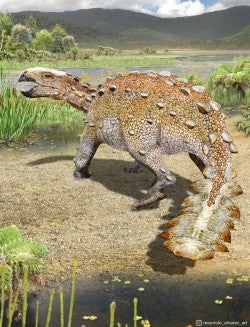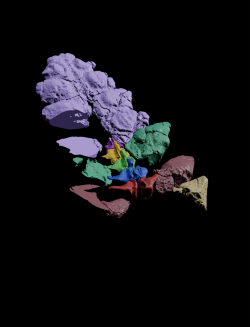Scientists find strange new dinosaur in Chile with a tail that looks like a battle axe
The new species has a tail unlike any other creatures that lived at that time
Your support helps us to tell the story
From reproductive rights to climate change to Big Tech, The Independent is on the ground when the story is developing. Whether it's investigating the financials of Elon Musk's pro-Trump PAC or producing our latest documentary, 'The A Word', which shines a light on the American women fighting for reproductive rights, we know how important it is to parse out the facts from the messaging.
At such a critical moment in US history, we need reporters on the ground. Your donation allows us to keep sending journalists to speak to both sides of the story.
The Independent is trusted by Americans across the entire political spectrum. And unlike many other quality news outlets, we choose not to lock Americans out of our reporting and analysis with paywalls. We believe quality journalism should be available to everyone, paid for by those who can afford it.
Your support makes all the difference.A new dinosaur species with a flat, weaponised tail resembling a battle axe has been unearthed in Chile.
Scientists discovered the new species which has a tail with a battle axe-like structure unlike the ones seen in any other creatures of the time, they said in a study that sheds more light on the origin and evolution of armoured dinosaurs published in the journal Nature on Wednesday.
The dinosaur, named Stegouros elengassen, was about two metres in size and resembled heavily armoured ankylosaurs that had a club at the end of their tails, said the researchers, including Alexander Vargas from the Universidad de Chile.
In the research, scientists assessed well preserved and mostly complete fossils pertaining to the late Cretaceous period – around 71.7 million to 74.9 million years ago – which were unearthed in the Magallanes province in Patagonia, Chile’s southernmost region.
The findings provide fresh insights into the origin and early evolution of armoured dinosaurs such as stegosaurs that had tail spikes and ankylosaurs whose tails had heavy clubs at the end.
The newly discovered species had distinctive skull features similar to those seen in other ankylosaurs. The rest of its skeleton, however, was largely primitive, with some properties resembling stegosaurs, according to the scientists.
“Stegouros shows ankylosaurian cranial characters, but a largely ancestral postcranial skeleton, with some stegosaur-like characters,” they wrote in the study.

The research particularly highlighted the dinosaur’s large tail weapon composed of seven pairs of flattened, bony deposits fused together in a structure that resembled a frond across the outer part of its tail.
“Stegouros elengassen gen. et sp. nov. evolved a large tail weapon unlike any dinosaur: a flat, frond-like structure formed by seven pairs of laterally projecting osteoderms encasing the distal [outer] half of the tail,” the study noted.
This battle axe-like structure differentiated it from the paired spikes and clubs of other armoured dinosaurs, the scientists said.

Reconstructing the family tree of Stegouros and comparing it with similar dinosaurs, the researchers found it to be a “transitional ankylosaur” related to the Kunbarrasaurus from Australia and Antarctopelta from Antarctica.
While such armoured dinosaurs from Laurasia – the northern landmass of what was once the Pangaea supercontinent – are diverse and well studied, researchers said those from southern Gondwana are “rare and poorly understood.”
Branches of the ankylosaur family tree may have existed in Laurasia and Gondwana after the final separation of these supercontinents in the late Jurassic period about 163 to 145 million years ago, the scientists said.
The earliest kinds of ankylosaurs may have lived in Gondwana and studying them may provide new clues to the origins and evolution of armoured dinosaurs, the scientists pointed out.
Join our commenting forum
Join thought-provoking conversations, follow other Independent readers and see their replies
Comments